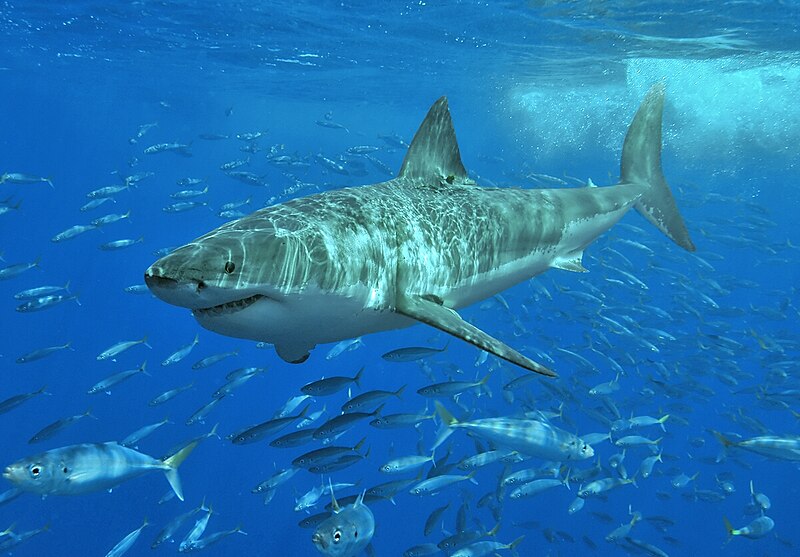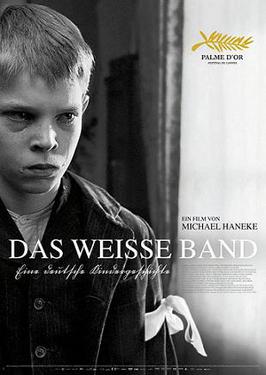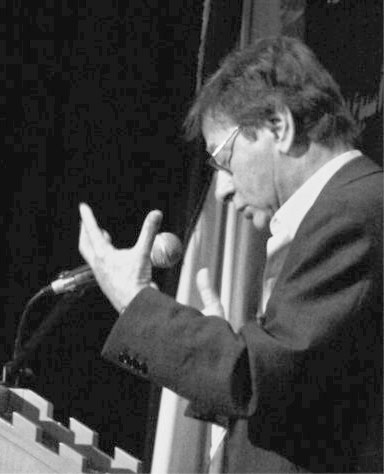.

Because they are strong and proud, they get a chance to be silly.
The old sharks move out to the deeps, hungry, restless and driven.
They are only serious.

Beyond the Pale






One must have a mind of winter
To regard the frost and the boughs
Of the pine-trees crusted with snow;
And have been cold a long time
To behold the junipers shagged with ice,
The spruces rough in the distant glitter
Of the January sun; and not to think
Of any misery in the sound of the wind,
In the sound of a few leaves,
Which is the sound of the land
Full of the same wind
That is blowing in the same bare place
For the listener, who listens in the snow,
And, nothing himself, beholds
Nothing that is not there and the nothing that is.
The Snow Man: Wallace Stevens, from The Collected Poems of Wallace Stevens
Cat dancing in snow: photo by Matthias Zirngibl, 2006


Cold floating days, difficult to keep body
Temp. up as planet cools off mysteriously
This P.M. two small grey birds bump
About in the rose bush for a while
A capella (no rush hour for once)
In last rays of tinny Christmas sun
While voluntary trumpets are quietly
Emitted by radio into Jerusalem foiled sky
Far off and to our great astonishment
O blue earth sounds your golden flower
From the bell of its silver horn
I didn’t think it would ever come back on
House sparrow (Passer domesticus) with winter plumage: photo by 3268zauber, 3 January 2009
French horn: photo by BenP, 2006

The entire universe is composed of stellar systems. In order to create them nature has only one hundred simple bodies at its disposal. Despite the prodigious profit it knows how to make from its resources, and the incalculable number of combinations these allow its fecundity, the result is necessarily a finite number, like that of the elements themselves. And in order to fill the entire expanse nature must infinitely repeat each of its original or generic combinations.
Every star, whatever it might be, thus exists in infinite number in time and space, not only in one of its aspects, but as it is found in every second of its duration, from birth until death. All the beings spread across its surface, big or little, animate or inanimate, share in this privilege of perennity.
Multiverse (cyclic progressions of the universe): image by KronicTOOL, 2009
The sun, as seen from the surface of earth through a camera lens: photo by Lykaestria, 2005
The earth is one of these stars. Every human being is thus eternal in every second of its existence. What I write now in a cell in the fort of Taureau I wrote and will write under the same circumstances for all of eternity, on a table, with a pen, wearing clothing. And so for all.
One after another all these earths are submerged in renovatory flames, to be re-born there and to fall into them again, the monotonous flowing of an hourglass that eternally turns and empties itself. It is something new that is always old; something old that is always new.
(Shelley)
Those curious about extra-terrestrial life will nevertheless smile at a mathematical conclusion that grants them not only immortality but eternity. The number of our doubles is infinite in time and space. In all conscience, we can hardly ask for more. These doubles are of flesh and blood, or in pants and coats, in crinoline and chignon. These aren’t phantoms: they are the now eternalized.
There is nevertheless a great defect: there is, alas, no progress! No, these are vulgar re-editions, repetitions. As it is with editions of past worlds, so it is with those of future worlds. Only the chapter of bifurcations remains open to hope. Never forget that all we could have been here, we are somewhere else.
(Donne)
White dwarf star in orbit around Sirius: artist's impression: G. Bacon (NASA/ESA)
Progress here is only for our nephews. They are luckier than us. All the beautiful things that our globe will see our future descendants have already seen, see now, and will always see in the form of doubles who preceded them and who follow them. Children of a better humanity, they have already scoffed at us and mocked us on dead earths, passing there after us. From living earths from which we have disappeared they continue to condemn us; and on earths to be born, they will forever pursue us with their contempt.
They and we, as well as all the guests of our planet, are born over again as prisoners of the moment and place that destiny assigns us in its series of avatars. Our perennity is an appendix of its perennity. We are but partial phenomena of its resurrections. Men of the 19th Century, the hour of our apparition is forever fixed, and we are returned always the same, at best with the possibility of happy variants. There is nothing much there to satisfy the thirst for what is better. What then is to be done? I haven’t sought my happiness; I have sought after truth. You will find here neither a revelation nor a prophet, but a simple deduction from the spectral analysis and cosmogony of Laplace. These two discoveries make us eternal. Is this a godsend? We should profit from it. Is it a mystification? We should resign ourselves to it.
Crab Nebula: mosaic image taken by Hubble Telescope (NASA)
But isn’t it a consolation to know ourselves to constantly be, on millions of planets, in the company of our beloved, who is today naught but a memory? Is it another, on the other hand, to think that we have tasted and will eternally taste this happiness in the shape of a double, of millions of doubles! Yet this is what we are. For many of the small minded this happiness through substitutes is somewhat lacking in rapture. They would prefer three or four supplementary years of the current edition to all the duplicates of the infinite. In our century of disillusionment and skepticism we are keen at clinging to things.
But deep down this eternity of man through the stars is melancholy, and sadder still this sequestration of brother-worlds through the barrier of space. So many identical populations that pass each other without suspecting their mutual existence! But yes! It has finally been discovered at the end of the 19th Century. But who will believe it?

Mira, oscillating red giant : Margarita Karovska, 1997 (Harvard-Smithsonian Center for Astrophysics/NASA)
And in any event, up till now the past represented barbarism to us, and the future signified progress, science, happiness, illusion! This past has seen brilliant civilizations disappear without leaving a trace on all our double-worlds; and they will disappear without leaving anymore of them. On millions of earths the future will see the ignorance, stupidity, and cruelty of our former ages.
At the present time the entire life of our planet, from birth until death, is being detailed day by day with all its crimes and misfortunes on a myriad of brother-stars. What we call progress is imprisoned on every earth, and fades away with it. Always and everywhere in the terrestrial field the same drama, the same décor; on the same limited stage a boisterous humanity, infatuated with its greatness, believing itself to be the universe, and living in its prison as if it were immense spaces, only to soon fall along with the globe that carried — with the greatest disdain — the burden of its pride. The same monotony, the same immobility on foreign stars. The universe repeats itself endlessly and paws the ground in place. Eternity infinitely and imperturbably acts out the same performance.
Level II Multiverse ("Bubble Universes"): original image by K123456789y, 2006; vectorisation by Lokal Profit, 2008
The reflection nebula NGC 1999 illuminated by V380 Orionis (NASA)

Louis Auguste Blanqui, L'éternité par les astres, Librairie Germer Bailliére, 1872, Paris; trans. Mitch Abidor for marxists. org (with variants).

Mixed deciduous forest, Stara Planina, Bulgaria: photo by Snezana Trifunovic, 2007


